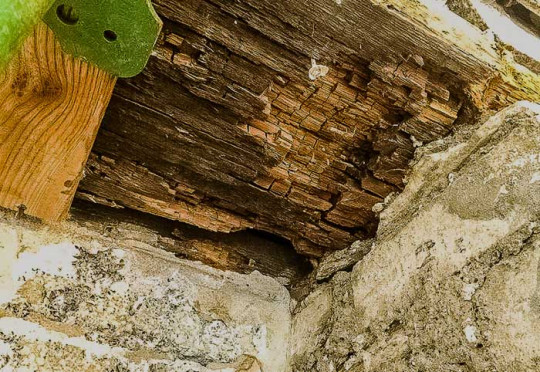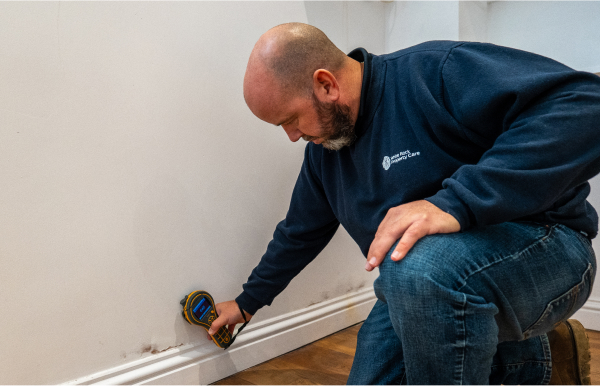Wet Rot fungi obtain their food by breaking down the walls of wood cells resulting in a loss of strength of the wood.
Although not as destructive as dry rot, it is more common and can still cause severe structural damage if allowed to go unchecked. Fortunately, at White Rock Property Care, we provide our customers with an effective Wet Rot treatment service, which prevents the regeneration of the rot efficiently, carefully and professionally.
What Causes Wet Rot?
Wet Rot cannot begin attacking wood unless there is a moisture content of at least 20% and, thus, does not normally occur in internal timbers unless there is significant damp. Most cases of Wet Rot arise due to rainwater entering the fabric of a building through external defects. These can include leaking gutters, defective air bricks and damaged roof tiles. Dealing with these issues is often important in preventing future attacks.
Other possible sources of moisture in a property include rising damp and condensation. Either way, if timber is exposed to moisture for an extensive period of time, wet rot spores will germinate and the wet rot will spread.
How Do I Spot Wet Rot?
Wet Rot can appear in several different forms, depending the environment around it and the conditions within a property.
Cellar fungus (Coniophora Puteana)
This type of Wet Rot fungi is usually found in damp basements, under floors and in skirting boards. It causes timber to darken and produce cracking both along and across the grain of the wood. It prefers very damp conditions in areas like basements, leaking roofs and wood floors where there is insufficient ventilation, or measures such as damp proofing have not yet been taken to prevent a wet rot outbreak.
Mine fungus (Fibroporia Vaillantii)
This Wet Rot fungi causes wood to shrink and split into cuboidal sectors. Its strands are white and sometimes fern-like.
Phellinus contiguous
This type of Wet Rot, white in colour, bleaches wood, which becomes fibrous and stringy. This is a common type of wood rot decay in external joinery timbers such as door and window frames.
What Are The Symptoms?
Fortunately, Wet Rot is easily identifiable if you look in the correct places. There are a few common signs of Wet Rot which will allow you to identify and eradicate the problem in its earliest form:
Timber will have a brittle texture
Due to the high levels of moisture, timber will begin to breakdown causing a weakened structure and a sponge like texture. As well as this, the wood and timber will appear to have a deeper colour to its original shade.
Weakened Floorboards
One of the most difficult things for property owners trying to identify Wet Rot is that issues can occur in places we cannot see or reach. In many cases the problems are, literally, right under our feet. Whilst your floors may look unaffected on the surface, there is always potential that there could be a Wet Rot issue beneath your floorboards, so keep your eye out and try to notice any springy feeling when you’re walking across your floors as this may indicate a breakdown of the structure of the wood.
Cracking of the timber
If you have come across what you think is a Wet Rot issue there are a few tell-tale signs that will enable you to identify the matter. One of the most common signs of wood rot is the cracking of the wood, this may appear cuboidal or linear depending on the type of Rot.
Presence of a damp smell
Luckily, for those situations where Wet Rot cannot be seen or felt, a damp smell will usually indicate a problem. Water ingress can lead to damp within a property and it is the smell of damp that can lead to a Wet Rot issue. The smell is often described as ‘musty’ and the air can sometimes feel damp too. If it’s something you recognise, there's definitely some further digging to do.
Fungal growth
Like Dry Rot, the spread of mycelium growth may appear over adjacent masonry. The spread of mycelium with Wet Rot, however, will be somewhat limited in comparison. Tell-tale signs of mycelium growth include the presence of thin web-¬like strands spreading across the surface of the wood. The strands grow to search for new sources of food to allow the spread to continue.
If you think any of these symptoms are present in your property, don’t delay in calling us for a complete timber survey.
How to treat Wet Rot
When treating Wet Rot, the main priority is to stop the source of moisture and to dry out any surrounding areas of the infestation. Being proactive in seeking advice/treatment is essential. In doing so, you will prevent the regeneration of Rot for the future. The eradication procedure of Wet Rot is dependent on the severity of the issue. In most cases, minimal areas of infected timber will need to be cut out, replaced and potentially sprayed with a fungicidal treatment.
In more serious circumstances, where the structural timber of a property has been significantly weakened, the recommendation of a Wet Rot specialist is advisable as large amounts of infected timber may need to be replaced to ensure the structural integrity of your property is safe for you and your family.
White Rock Property Care have amassed extensive experience in Wet Rot treatment, having surveyed & treated countless cases over recent years. Our fully trained and PCA accredited, experienced surveyors will identify the type, and the extent, of any decay and will produce a suitable specification for the treatment and eradication of the problem.
This will be furthered by a 10 year guarantee for the work carried out giving you the peace of mind and reassurance that your property is in the safest of hands.
Our trained surveyors and technicians will:
Identify the nature, type and extent of the decay
Determine the cause, finding the source of moisture and drying out the surrounding area
Propose the cure for the rot with full specification and method statement for the rot treatments
Where timber affected by Wet Rot has lost its strength timber would have to be removed and replaced
Advise what additional steps (if any) are required to safeguard the property



